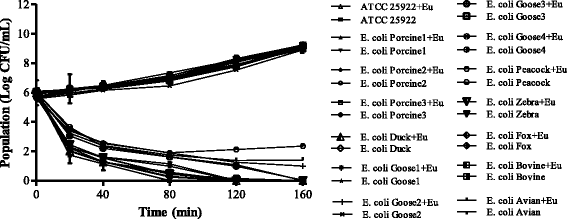Synergistic effect of eugenol with Colistin against clinical isolated Colistin-resistant Escherichia coli strains
- PMID: 29423192
- PMCID: PMC5789579
- DOI: 10.1186/s13756-018-0303-7
Synergistic effect of eugenol with Colistin against clinical isolated Colistin-resistant Escherichia coli strains
Abstract
Background: Bacterial infections have become more challenging to treat due to the emergence of multidrug-resistant pathogenic bacteria. Combined antibiotics prove to be a relatively effective method to control such resistant strains. This study aim to investigate synergistic activity of eugenol combined with colistin against a collection of clinical isolated Escherichia coli (E.coli) strains, and to evaluate potential interaction.
Methods: Antimicrobial susceptibility, minimum inhibitory concentration (MIC) and fractional inhibitory concentration index (FICI) of the bacteria were determined by disk diffusion assay, broth microdilution method and checkerboard assay, respectively. The mcr-1 mRNA expression was measured by Real-time PCR. To predict possible interactions between eugenol and MCR-1, molecular docking assay was taken.
Results: For total fourteen strains including eight colistin-resistant strains, eugenol was determined with MIC values of 4 to 8 μg/mL. Checkerboard dilution test suggested that eugenol exhibited synergistic activity when combined with colistin (FICI ranging from 0.375 to 0.625). Comparison analysis of Real-time PCR showed that synergy could significantly down-regulate expression of mcr-1 gene. A metal ion coordination bond with catalytic zinc atom and a hydrogen bond with crucial amino acid residue Ser284 of MCR-1 were observed after molecular docking, indicating antibacterial activity and direct molecular interactions of eugenol with MCR-1 protein.
Conclusions: Our results demonstrated that eugenol exhibited synergistic effect with colistin and enhanced its antimicrobial activity. This might further contribute to the antibacterial actions against colistin-resistant E.coli strains.
Keywords: colistin-resistant Escherichia coli; eugenol; mcr-1 gene; molecular docking.
Conflict of interest statement
Not applicableNot applicableThe authors declare that they have no competing interests.Springer Nature remains neutral with regard to jurisdictional claims in published maps and institutional affiliations.
Figures



References
-
- Liu YY, Wang Y, Walsh TR, Yi LX, Zhang R, Spencer J, Doi Y, Tian G, Dong B, Huang X, et al. Emergence of plasmid-mediated colistin resistance mechanism mcr-1 in animals and human beings in china: a microbiological and molecular biological study. Lancet Infect Dis. 2016;16:161–168. doi: 10.1016/S1473-3099(15)00424-7. - DOI - PubMed
-
- von Wintersdorff CJ, Wolffs PF, van Niekerk JM, Beuken E, van Alphen LB, Stobberingh EE, Oude Lashof AM, Hoebe CJ, Savelkoul PH, Penders J. Detection of the plasmid-mediated colistin-resistance gene mcr-1 in faecal metagenomes of dutch travellers. J Antimicrob Chemother. 2016;71:3416–3419. doi: 10.1093/jac/dkw328. - DOI - PubMed
Publication types
MeSH terms
Substances
LinkOut - more resources
Full Text Sources
Other Literature Sources

